Task
QUESTION 1
Decision Analysis
Show all calculations to support your answers. Round all probability calculations to 2 decimal places.
A member of a group of medical practitioners is considering opening his own private medical practice. He estimates that if demand for his services is high he could realise a profit of $500,000. If demand is low he could lose $200,000.
(a) If the medical practitioner follows the criterion of regret what should he do?
His best guess is that there is a 50-50 chance that the practice would be successful.
(b) What should he do if he follows the EMV criterion?
(c) What is the expected value of perfect information?
A market research firm offers to perform a study of the market for a fee of $25,000. Their past experience enables them to make the following claims:
There is a 90% chance that they would successfully predict a favourable market (ie demand would be high) and an 80% chance they would successfully predict an unfavourable market.
(d) Using the market research experience, calculate the revised probabilities of demand given predictions of a favourable market and an unfavourable market.
(e) Based on these revised probabilities what should the medical practitioner do? Support your answer with EVSI and ENGSI calculations.
(f) Tversky and Kahneman describe three types of heuristics that people use in judgments under uncertainty. What do they mean by the term heuristics? Briefly describe the ones that they mention.
Give one example from your own experience of a bias that might result from each of these heuristics.
QUESTION 2 Simulation
The State Opera Theatre gains significant revenue from ticket sales at each opera performed during the season. The sale of souvenir programs for all performances of each opera also adds to profitability.
Each program costs $1.60 to produce and sells for $4.00. Any programs unsold at the end of any opera are donated to a recycling centre and do not produce any revenue. Records of the programs sold for each opera show the following:
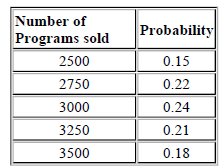
(a) Your manager has asked you to determine the profitability of the souvenir program production.
You decide to use Excel to simulate the sale of programs at 10 operas in a season together with the profit or loss on programs for each opera. You decide to investigate the strategy where the number of programs to be printed should be the number sold at the previous opera. You will have to generate a dummy sale for a "previous" opera to begin with. Include a calculation of the total profit/loss for the season and the average profit/loss per opera.
Show the data and the model in two printouts: (1) the results, and (2) the formulas. Both printouts must show row and column numbers and be copied from Excel into Word. (You can do this using the Print Screen command in Excel and then pasting (or CTRL+V) in the Word document.
(b) If the theatre management decided to print 3000 programs for each opera calculate the profit or loss in each of the 10 operas and the average profits for the whole season. You can do this using your Simulation model in (a) and adjusting where necessary to incorporate any additional or differentcalculations. Which of the two production strategies (the one in (a) or the one in (b) provides the higher profit for the season and on average?
(c) Write a report to your manager advising
(1) the advantages and disadvantages of simulation models; and
(2) why a manager might be forced to use simulation instead of an analytical model in dealing with:
(i) an inventory ordering policy, and
(ii) bank teller windows
QUESTION 3 Relevant Costs and Transfer Pricing
AB Company specialises in electronic products. Division A makes integrated circuits and sells 90% of its output to outside companies. This division is operating well below capacity.
Division B has developed a new product codenamed XK120 that could use the circuit made by Division A. The manager of Division A has quoted a transfer price of $80 per circuit, which is below the current market price, and which would provide a $40 contribution margin.
The accountant of Division B has provided the following estimates of costs for XK120:
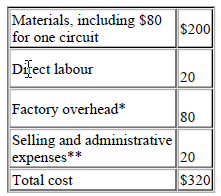
* $40 fixed, $40 variable, **$10 fixed, *10 variable
The marketing manager of Division B has submitted the following estimates of their demand schedule for XK120:
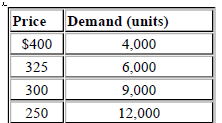
Division A has enough capacity to meet the 12 000 maximum volume that Division B could obtain.
Divisional managers are evaluated on ROI, and total investment would be the same for any of thevolumes that Division B may sell.
(a) As the manager of Division B, given the transfer price of $80, what price would you charge for XK120 and what volume would you sell?
(b) Given the price calculated in (a), what total contribution would be earned by:
(i) Division A?
(ii) Division B?
(d) From the point of view of the managing director of AB Company, what price should Division B charge for XK120, and what volume should be sold in order to maximise return on investment for the company as a whole?
(e) If the volume calculated in (c) were to be met, what is the minimum transfer price that could be accepted by Division A so that its total contribution would be no less than that calculated in (b)(i)?
(f) If the volume calculated in (c) were to be met, what is the maximum transfer price that could be paid by Division B so that its total contribution would be no less than that calculated in (b)(ii)? (4marks)
(g) If the managing director is determined that Division B should sell that volume which produces the optimum result for the company as a whole, what justification could be given to the divisional manager of Division A in requiring him to accept a transfer price equal to that calculated in (e)?
QUESTION 4 Cost Estimation
The CEO of Milton Manufacturing Company has asked you to develop a cost equation to predict monthly overhead costs in its production department. You have collected the following data for the last 10 months: Overhead costs (OH$) and the proposed independent variables: Number of machine hours worked (MH), number of direct labour hours (DLH) and number of indirect labour workers
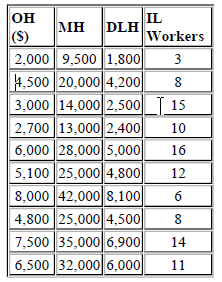
(a) The CEO suggests that he has heard that the high-low method of estimating costs works fairly well and should be inexpensive to use. Write a response to this suggestion for the CEO indicating the advantages and disadvantages, including the calculation of a cost equation for this data using MH as the cost driver.
(b) Using Excel develop three scatter diagrams showing overhead costs against each of the proposed independent variables. Comment on whether these scatter diagrams indicate that linearity is a reasonable assumption for each.
(c) Using the regression module of Excel's Add-in Data Analysis, perform 3 simple regressions by regressing overhead costs against each of the proposed independent variables. Evaluate each of the regression results, indicating which is best and why. Provide the cost equations for those regression results which are satisfactory and from them calculate the predicted overhead in a month where there were 10,000 MH and 3,000 DLH worked.
(d) Selecting the two best regressions from part (c) conduct a multiple regression of overhead against these two independent variables. Evaluate the regression results. If there should be a problem identify the problem and draw conclusions about the best of the four regression results to use.
QUESTION 5 CVP Analysis and Linear Programming
Ace Electronics can produce four potential products: MP3 Players, CD Players, Digital Radios and DVD players. There are three major inputs for all products: electronic components, other components and assembly time.
Electronic components cost $14 each, other components $10 each and assembly time $20 per hour. Consumption of theses inputs per unit of product together with total available monthly supply of components are shown below:
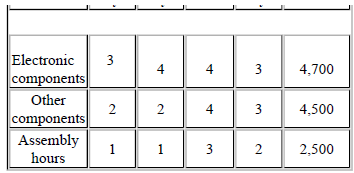
Selling price of the product are.

Fixed costs per month amount to $12,000.
(a) Calculate the contribution margin for each product.
(b) If management wishes to produce and sell Mp3s, Cds, Digital Radios and DVDs in the ratio 4:3:2:1, how many units of each should management plan to produce and sell in a month to earn a profit before tax of $70,000?
(c) Instead of producing the product mix in part (b), management wishes to use linear programming to find the profit-maximising mix. Write an LP model, and then use Excel's Solver to determine the optimum weekly mix and the resulting weekly profit before tax.
(d) Competitive pressures will probably force management to reduce the price for DVD players. What is the maximum price reduction that can be sustained such that the optimum mix calculated in part (c) remains optimum?
(e) What is the shadow price for Electronic Components? Explain to management how they might use this to increase profits? Calculate the upper limit for which this shadow price is valid. What happens when the upper limit is breached?
(f) Explain why linear programming is referred to as a resource allocation technique? Give examples of three different types of problems that can be solved via linear programming.